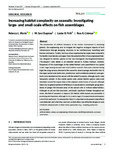Increasing habitat complexity on seawalls: Investigating large‐ and small‐scale effects on fish assemblages
| dc.contributor.author | Morris, Rebecca | |
| dc.contributor.author | Chapman, MG | |
| dc.contributor.author | Firth, Louise | |
| dc.contributor.author | Coleman, Ross | |
| dc.date.accessioned | 2018-01-19T12:18:06Z | |
| dc.date.available | 2018-01-19T12:18:06Z | |
| dc.date.issued | 2017-11 | |
| dc.identifier.issn | 2045-7758 | |
| dc.identifier.issn | 2045-7758 | |
| dc.identifier.uri | http://hdl.handle.net/10026.1/10608 | |
| dc.description.abstract |
<jats:title>Abstract</jats:title><jats:p>The construction of artificial structures in the marine environment is increasing globally. Eco‐engineering aims to mitigate the negative ecological impacts of built infrastructure through designing structures to be multifunctional, benefiting both humans and nature. To date, the focus of eco‐engineering has largely been on benefits for benthic invertebrates and algae. Here, the potential effect of eco‐engineered habitats designed for benthic species on fish was investigated. Eco‐engineered habitats (“flowerpots”) were added to an intertidal seawall in Sydney Harbour, Australia. Responses of fish assemblages to the added habitats were quantified at two spatial scales; large (among seawalls) and small (within a seawall). Data were collected during high tide using cameras attached to the seawall to observe pelagic and benthic fish. At the larger spatial scale, herbivores, planktivores, and invertebrate predators were generally more abundant at the seawall with the added flowerpots, although results were temporally variable. At the smaller spatial scale, certain benthic species were more abundant around flowerpots than at the adjacent control areas of seawall, although there was no general pattern of differences in species density and trophic group abundance of pelagic fish between areas of the seawall with or without added habitats. Although we did not find consistent, statistically significant findings throughout our study, the field of research to improve fish habitat within human‐use constraints is promising and important, although it is in its early stages (it is experimental and requires a lot of trial and error). To advance this field, it is important to document when effects were detected, and when they were not, so that others can refine the designs or scale of habitat enhancements or their study approaches (e.g., sampling protocols).</jats:p> | |
| dc.format.extent | 9567-9579 | |
| dc.format.medium | Electronic-eCollection | |
| dc.language | en | |
| dc.language.iso | eng | |
| dc.publisher | Wiley | |
| dc.subject | artificial habitat | |
| dc.subject | camera | |
| dc.subject | eco-engineering | |
| dc.subject | infrastructure | |
| dc.subject | retrofitting biodiversity | |
| dc.subject | rock pool | |
| dc.subject | urbanization | |
| dc.title | Increasing habitat complexity on seawalls: Investigating large‐ and small‐scale effects on fish assemblages | |
| dc.type | journal-article | |
| dc.type | Journal Article | |
| plymouth.author-url | https://www.webofscience.com/api/gateway?GWVersion=2&SrcApp=PARTNER_APP&SrcAuth=LinksAMR&KeyUT=WOS:000415900800030&DestLinkType=FullRecord&DestApp=ALL_WOS&UsrCustomerID=11bb513d99f797142bcfeffcc58ea008 | |
| plymouth.issue | 22 | |
| plymouth.volume | 7 | |
| plymouth.publication-status | Published | |
| plymouth.journal | Ecology and Evolution | |
| dc.identifier.doi | 10.1002/ece3.3475 | |
| plymouth.organisational-group | /Plymouth | |
| plymouth.organisational-group | /Plymouth/Faculty of Science and Engineering | |
| plymouth.organisational-group | /Plymouth/Faculty of Science and Engineering/School of Biological and Marine Sciences | |
| plymouth.organisational-group | /Plymouth/REF 2021 Researchers by UoA | |
| plymouth.organisational-group | /Plymouth/REF 2021 Researchers by UoA/UoA07 Earth Systems and Environmental Sciences | |
| plymouth.organisational-group | /Plymouth/Users by role | |
| plymouth.organisational-group | /Plymouth/Users by role/Academics | |
| dc.publisher.place | England | |
| dcterms.dateAccepted | 2017-09-02 | |
| dc.identifier.eissn | 2045-7758 | |
| dc.rights.embargoperiod | Not known | |
| rioxxterms.versionofrecord | 10.1002/ece3.3475 | |
| rioxxterms.licenseref.uri | http://www.rioxx.net/licenses/all-rights-reserved | |
| rioxxterms.licenseref.startdate | 2017-11 | |
| rioxxterms.type | Journal Article/Review |


